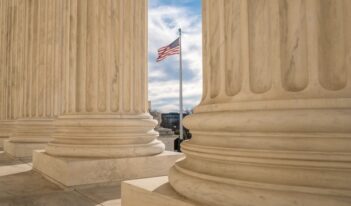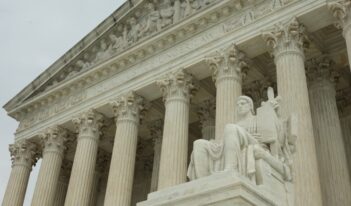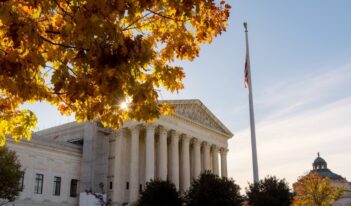
A three-way split in Virginia Uranium v. Warren presents conflicting views of preemption.
Surrounded by 5-4 nail-biters, the 3-3-3 split generated by Virginia Uranium v. Warren has attracted less attention than its more high-profile cousins. Although the issue presented in the case—whether the Atomic Energy Act preempts Virginia’s blanket ban on uranium mining—will have little lasting relevance beyond the parties themselves, the case’s tripartite resolution will have broader implications.
In three separate opinions, the justices staked out dramatically different conceptions of the appropriate contours of preemption—a doctrine that requires federal law to supersede state law under certain conditions. These different views may in time come to bear not only on preemption but also on other core doctrines affecting federal courts.
Virginia Uranium concerned, predictably, Virginia uranium.
In the late 1970s, the largest known domestic deposit of uranium ore was discovered under Coles Hill, Virginia. Uranium is recovered in three steps. First, uranium ore is mined. Second, the ore is milled into fine particles, which are mixed with a chemical solution to leach out the uranium. Third, the leached solution is dried into a solid concentrate for use in nuclear reactors. The remaining radioactive toxic slurry, known as mine tailings, must be appropriately stored to avoid contamination and associated health hazards.
The Atomic Energy Act commits the regulation of the second and third steps—milling and tailings—exclusively to the federal government, leaving regulation of the first step—uranium mining—to the states. In short, federal law kicks in only after uranium ore is removed from the ground. Exercising this liberty, following the discovery of the Coles Hill deposit, the Commonwealth of Virginia prohibited all uranium mining.
Although the ban on its face regulates—eliminates, actually—uranium mining, the ban has the necessary effect of also reducing, if not eliminating, uranium ore milling and tailings. Virginia appears to have acknowledged that the ban was motivated by concerns over radiation hazards from milling and tailings.
Petitioner, Virginia Uranium, Inc., challenged the ban as preempted by subsection (k) of the Atomic Energy Act, which preserves state regulatory authority “for purposes other than protection against radiation hazards.”
This provision, Virginia Uranium argued, demonstrated the Act’s purpose of preempting state laws that do, in fact, regulate activities to protect against radiation hazards. Because Virginia had copped to such an intent, Virginia Uranium claimed that the mining ban had to go.
Three dissenting justices agreed with Virginia Uranium that the Act preempted the Virginia ban, because the ban had the purpose of regulating milling and tailings. In contrast, the six remaining justices all concluded that the Act did not preempt Virginia’s ban on uranium mining—but for very different reasons.
The three Virginia Uranium opinions are best understood backwards, starting with the opinion of the three dissenting justices.
Chief Justice John Roberts’ dissent, joined by Justices Samuel Alito and Stephen Breyer, is the most straightforward, in that it relied principally on PG&E v. State Energy Resources Conservation and Development Commission. In PG&E, the Court rejected a similar preemption challenge to California’s ban on construction of new nuclear power plants. Although the Atomic Energy Act did not address whether to build new nuclear plants, it did regulate how to build them. Declaring consideration of subsection (k) to be a “necessary” step in the analysis, the Court evaluated the purpose of the California ban and upheld it against preemption only because California articulated an alternative, non-radiological justification.
Applying PG&E to Virginia Uranium, the dissent stated that Virginia may not regulate the non-preempted field of mining safety with the purpose and effect of indirectly regulating the preempted field of milling and tailings.
Justice Ruth Bader Ginsburg, joined by Justices Elena Kagan and Sonia Sotomayor, disagreed with the dissent and concurred in the judgment that the Atomic Energy Act does not preempt Virginia’s uranium mining ban. In a workmanlike opinion, the concurrence first concluded that the Act does not occupy the field of laws concerning radiological hazards—and that PG&E did not require differently, because California’s ban on new nuclear power plants necessarily regulated power plant construction, a federally regulated activity.
The concurrence also rejected conflict preemption, stating that far from upsetting Congress’s “delicate balance” between securing nuclear power and promoting safety, the mining ban regulates an activity falling outside the Act entirely. The ban does not preempt, supplant, or supplement federal uranium milling or tailings storage regulations. Instead, it simply prohibits an upstream activity that would greatly reduce the amount of those activities occurring in Virginia. To the extent that ore or tailings enter Virginia, they still remain subject to federal law, unhindered by the mining ban.
Finally, Justice Neil Gorsuch’s lead opinion, joined by Justices Clarence Thomas and Brett Kavanaugh, similarly rejected field and conflict preemption. But unlike the concurring Justices who attempted to distinguish PG&E, the lead opinion openly doubted PG&E’s correctness as an initial matter. Justice Gorsuch then proceeded to take on preemption generally, describing it as a serious federal intrusion into state sovereignty. Moreover, he explained, preemption trammels Congress’s authority to delimit the preemptive effect of its laws.
For these reasons, Gorsuch argued that “field preemption” should turn on “what the state did, not why it did it.” Hinging preemption on legislators’ subjective intent would result in substantively identical laws being sustained or struck down depending solely on whether a legislator confessed improper intentions.
Gorsuch’s lead opinion also argued that “conflict preemption” should not turn on “abstract and unenacted legislative desires,” but only on duly enacted federal laws. Judges should no more hunt and peck through the federal legislative record than they should through the state record. “In piling inference upon inference about hidden legislative wishes we risk displacing the legislative compromises actually reflected in the statutory text,” Justice Gorsuch wrote. Legislators may have many different motivations for supporting a law, and the “only thing a court can be sure of is what can be found in the law itself.”
With respect to uranium mining, the Atomic Energy Act committed authority over radiological materials to the federal government after their removal from the ground, but left regulation of the actual mining to the states. In the plurality’s view, Congress’s choice not to regulate should be respected.
The real dispute in the case lies between Justice Gorsuch and Justice Ginsburg. Although agreeing in the result, the lead opinion and the concurrence state vastly different views of preemption. Justice Gorsuch expresses skepticism of preemption, grounded in both a federalist concern for preserving state prerogatives, and also a structural, separation of powers concern that the courts not usurp Congress’s power to legislate. Armed with the ability to scry legislative purpose, smart judges can readily expand federal law and override disfavored states laws. In Justice Gorsuch’s view, congressional silence should be treated as purposeful. In this case, for example, where uranium mining was plainly known to Congress, the choice not to regulate it should be respected as a positive choice, not an interstice to fill.
Justice Ginsburg, for her part, rejects the lead opinion as an “inappropriate” extended discussion that “sweeps well beyond the confines of this case.” In her view, preemption turns fundamentally on congressional purpose and she likely has faith in smart judges’ ability to find it. In this case, she did not perceive Congress as having intended to regulate mining in any way. But in a different case, the legislative clues could point in a different direction.
The disagreement between Justice Ginsburg and Justice Gorsuch has little to do with Coles Hill, Virginia, and everything to do with their respective understanding of what it means to be a judge. And, if a majority of the dissenters agree with either of these views, the resulting majority will guide preemption, displacement, and deference doctrine for the foreseeable future.
This essay is part of a series, entitled The Supreme Court’s 2018-2019 Regulatory Term.




